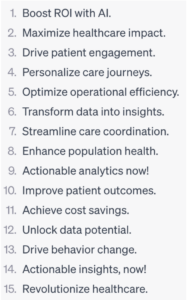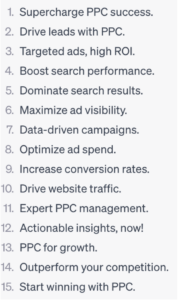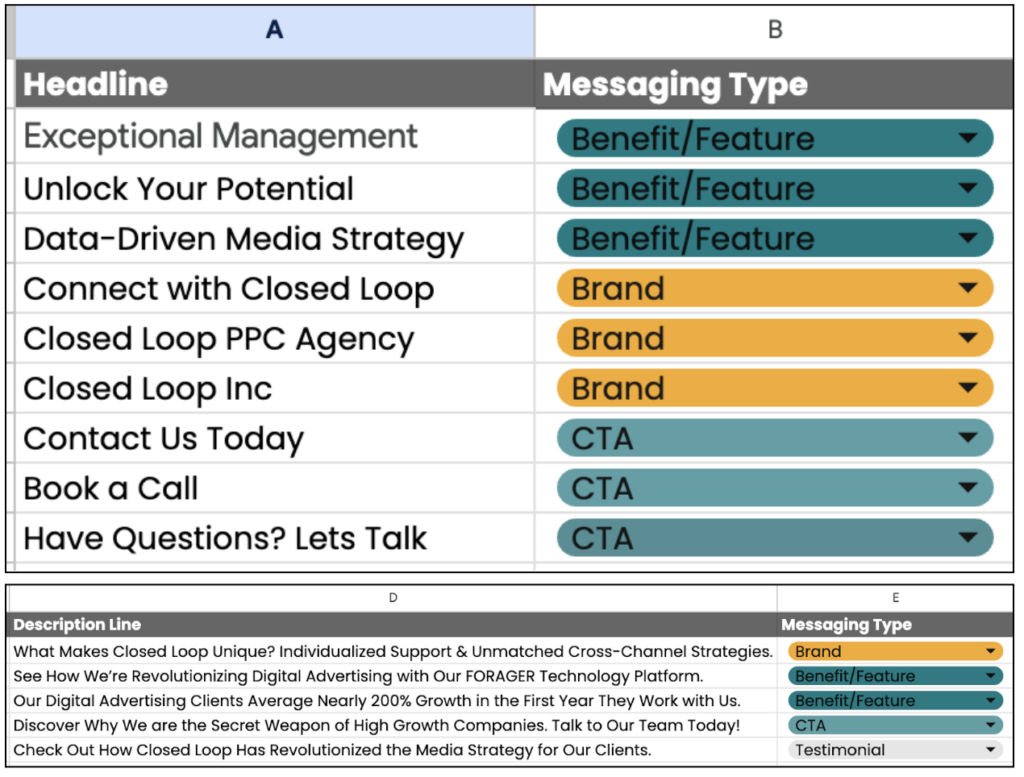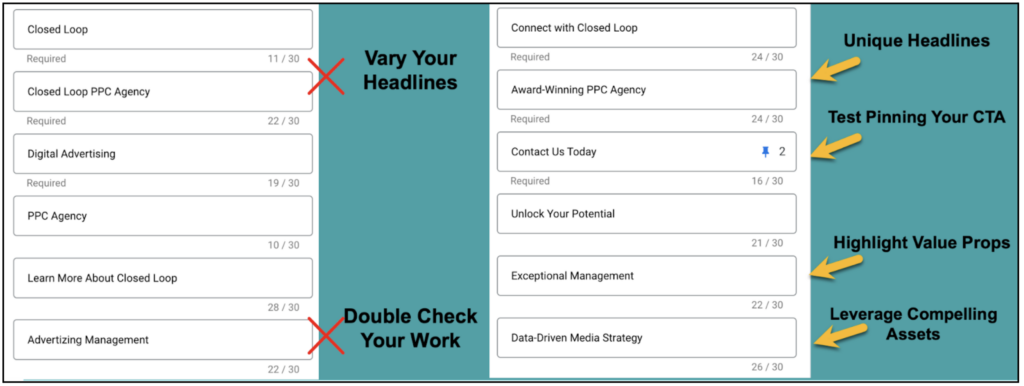Writing effective responsive search ad copy continues to be an important part of running successful Search campaigns. There are more AI levers to pull to help take your ad copy to the next level, but you still need to focus on creating a positive buyer journey. Overlooking ad copy can result in poor ad rank, lower impression share and missed opportunities. In today’s market, every dollar counts. That’s why advertisers must ensure they’re controlling the message in front of your highest value prospects and guaranteeing a better ROAS. Here are 10 helpful steps to write effective responsive search ads for your clients:
Improving the buyer journey has become more important than ever, especially as prospects become more savvy and judicious about where they want to invest their dollars. Your customers want to understand what they agree to once they click on an ad. Are you asking them to book a demo? Are they signing up for a paid service? Why should they fill out a form with their personal information? You can increase your CTR and CVR by outlining a clear buyer experience with clear CTAs. Testing pinning headlines to see if it improves down-funnel metrics is also important.
Testing is an important component of a successful search strategy because while you know what drives clicks, you may need to adjust how you nurture and speak to leads. Vague CTAs like “Learn More” will likely increase your bounce rate if you ask customers to book a demo or provide personal information to start a free trial on your landing pages. Test language like “Book a Pressure-Free Demo” or “Talk to Our Sales Experts” to help increase your CTR and drive high-value customers to your website. Test language like “Shop Our Exclusive Styles” or “Shop Now for Free Shipping” to help increase your CTR and drive high-value customers to your website.
Each platform has unique requirements, so it’s critical to consider the ad platform and how ads are served when writing copy. For search ads, including keywords in your headlines will improve ad rank and increase the likelihood that you are driving quality traffic to your website. It helps to remember that some potential customers might be familiar with your brand and what it offers, but headlines that match search keywords can help drive untapped markets to your ads. Including these same keywords in headlines and description lines can help improve your CTR and catch the eye of interested consumers.
For example, let’s say you’re trying to promote a successful PPC Agency. You know your top converting keywords are “PPC agency” and “media management.” You’d want to include headlines like “Award-Winning PPC Agency,” “Exceptional Media Management” and “Improve Paid Search Campaigns.” Not only is someone more likely to click on an ad that references the exact term they are searching for, but you’ll improve your ad rank by ensuring your keywords, ad copy and landing page language all align. Plus, you have some extra characters to add in additional adjectives that make your company stand out.
Every industry faces common pain points, so illustrate how your brand provides unique solutions. Bidding on keywords that speak to common pain points and solutions is a great way to drive new users to your tailored ad and increase site traffic. Potential buyers are savvier than ever and tend to have options, so use responsive search ads to your advantage and test ad copy that highlights your value props and makes you stand out from competitors. Showcase how your brand answers common pain points or allows customers to sample the product, such as “Save Time,” “Improve ROI,” “Free & Easy Returns” or “Start Your Free Trial.”
Frequently, a company has worked hard to curate language that aligns with brand guidelines and values. Comb through your website to make sure your landing pages use similar language to your search ads. You can use your description lines to highlight brand features, ROI statistics and solution-focused language. It also helps to look at additional assets like blog posts, client testimonials, case studies, etc., to ensure you are testing language that resonates with your audience. Including social proof stats and quotes is a great way to fill your ads with meaningful content.
We do not suggest you copy competitors’ actions in the same market. It’s quite the opposite. However, it can be helpful to see what language and strategy your top competitors use and make sure you differentiate your brand. Are they all using a similar CTA? Do they all use the same buzzwords like “competitive” or “affordable?” In this economic climate, showcasing why investing in your product is worth it is more important than ever.
We’ve all seen ads in the wild with typos and grammatical errors. We may have even seen the dreaded [copy placeholder] headline appear for a brand before. Nothing ruins your credibility faster than an ad that looks unprofessional or even unfinished. As always, double-check your work.
It can be easy to repeat CTAs and overuse a brand name when writing multiple headlines and description lines but don’t waste valuable real estate by falling victim to complacency. You can always pin assets to ensure a specific aspect of your brand or an offering is featured. Here are some simple ways to vary your language: talk to your sales team and see if there are value props you can reference, highlight integrations, mention ROI and talk directly to your ICPs. Also, don’t be afraid to lean on AI to help you test new ways of speaking to your audience.
With tools like ChatGPT and optimized ad rotations, Google has clarified that AI is the future of search. In fact, Matthew Umbro, a VP of Digital Advertising at ClosedLoop, wrote a great article on how ChatGPT complements Google Ads. Umbro does an excellent job of illustrating how you can use specific prompts to get ChatGPT to build ad copy based on specific landing pages and refine the results to fit the needs of your search strategy.
Following Matt’s advice, I wrote this prompt:
From this page: https://www.closedloop.com/, create fifteen headlines that are 30 characters or less. The headlines should include a combination of the benefits, features, value-adds, and call to actions listed on this page

Clearly, not all these headlines are perfect and some exceed our 30 character counts. I submitted a more tailored landing page and was given a new set of headlines:

The key here is to feed your AI tools with the best information possible and then spend your time tweaking ad copy to fit your specific ad groups and client needs. Save time where you can and use AI to help you deliver the best results possible for your clients. Advertisers still have an essential role here, but work smarter, not harder. Embracing AI means you have more time to curate high-level strategies, testing and optimizations.
This is when a thoughtful search strategy comes into play. Who are you targeting with your ads? Are you speaking to your ICP directly? Running the same ad copy across your campaigns might be time efficient, but you’re likely losing conversion volume by not speaking to your ideal customer. Our B2B clients often target mid-market and enterprise clients, but those markets have different needs and challenges. This is another area where AI can save you time, so you can leverage a thoughtful strategy to improve lead quality for your clients.
Sometimes what we think will draw customers to our site doesn’t always lead to high-value conversions. Feel free to re-evaluate your strategy and align the language used in your search ads with what’s associated with your brand across channels. RSA testing is also a great way to make landing page recommendations, improve your impression share and get to know what resonates with your audience.
Creating a robust ad copy bank, like the one below, can help you easily swap out underperforming ad copy and incorporate language beyond the standard value propositions for your market. Don’t be afraid to think outside the box: dig into client testimonials for further inspiration, and talk to key players outside your main point of contact (consider Sales teams, internal branding consultants or creative team members) to help curate language that leads to more conversions.

When it comes to actually implementing ad copy tests, things have gotten more complicated with smart bidding and RSAs. You can run experiments, but you can’t guarantee that your ads will be rotated evenly if you use smart bidding simultaneously. We’ve often found success by running two RSAs within the same ad group and monitoring the performance based on key KPIs (conversions, cost per conversion, CTR, etc). You want to ensure you’re focused on a specific testing variable, and by clicking on the view asset details below an ad, you can swap out underperforming headlines and description lines. Testing can help you consistently improve your account’s health and achieve sustainable growth for your clients.
You have 15 responsive headlines to work with, but make sure to include your brand name, a clear CTA, keywords and crucial value props. You can also run 4 description lines and have 90 characters to use, which is plenty of room to highlight what makes your brand stand out from competitors and why someone searching for your product should spend their hard earned dollars on what you’re offering.

Make sure your ad copy aligns with your landing pages, speaks directly to your audience, addresses different pain points & solutions, and utilizes enough variation so you can run tests to refine your strategy over time. Here’s a condensed cheat sheet with some examples that showcase how to make the most of your character count and assets:

Marketers have more tools than ever to help level up their ad copy game. Simultaneously, buyers are smarter and have more options, so leveraging tools like AI can help free up time so we can focus on the strategy behind the campaigns and responsive search ads we’re managing. Our clients have entrusted us with their brands, and it’s our job to make every character count.
All the latest digital advertising tips and industry insights delivered to your inbox every quarter
Running campaigns without Offline Conversion Tracking is like fishing blind—uncertain and inefficient. Learn how OCT connects CRM data to ad platforms, helping CMOs optimize for real business impact, from quality leads to closed deals.

The B2B landscape is relentless, and mediocre video production won’t cut it. Learn why scaling high-quality video production is essential to drive ROI, stand out, and stay competitive in today’s paid media game.

Misaligned metrics and fragmented strategies aren’t just inconvenient—they’re costing your marketing team revenue and results. Explore the root causes of data chaos and learn how to align your metrics for paid media success.